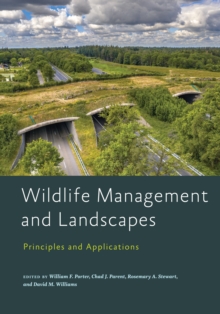Wildlife management specialists and landscape ecologists offer a new perspective on the important intersection of these fields in the twenty-first century.
It's been clear for decades that landscape-level patterns and processes, along with the tenets and tools of landscape ecology, are vitally important in understanding wildlife-habitat relationships and sustaining wildlife populations. Today, significant shifts in the spatial scale of extractive, agricultural, ranching, and urban land uses are upon us, making it more important than ever before to connect wildlife management and landscape ecology. Landscape ecologists must understand the constraints that wildlife managers face and be able to use that knowledge to translate their work into more practical applications. Wildlife managers, for their part, can benefit greatly from becoming comfortable with the vocabulary, conceptual processes, and perspectives of landscape ecologists.
In Wildlife Management and Landscapes, the foremost landscape ecology experts and wildlife management specialists come together to discuss the emerging role of landscape concepts in habitat management. Their contributions
make the case that a landscape perspective is necessary to address management questions
translate concepts in landscape ecology to wildlife management
explain why studying some important habitat-wildlife relationships is still inherently difficult
explore the dynamic and heterogeneous structure of natural systems
reveal why factors such as soil, hydrology, fire, grazing, and timber harvest lead to uncertainty in management decisions
explain matching scale between population processes and management
discuss limitations to management across jurisdictional boundaries and balancing objectives of private landowners and management agencies
offer practical ideas for improving communication between professionals
outline the impediments that limit a full union of landscape ecology and wildlife management
Using concrete examples of modern conservation challenges that range from oil and gas development to agriculture and urbanization, the volume posits that shifts in conservation funding from a hunter constituent base to other sources will bring a dramatic change in the way we manage wildlife. Explicating the foundational similarity of wildlife management and landscape ecology, Wildlife and Landscapes builds crucial bridges between theoretical and practical applications.
Contributors: Jocelyn L. Aycrigg, Guillaume Bastille-Rousseau, Jon P. Beckmann, Joseph R. Bennett, William M. Block, Todd R. Bogenschutz, Teresa C. Cohn, John W. Connelly, Courtney J. Conway, Bridgett E. Costanzo, David D. Diamond, Karl A. Didier, Lee F. Elliott, Michael E. Estey, Lenore Fahrig, Cameron J. Fiss, Jacqueline L. Frair, Elsa M. Haubold, Fidel Hernández, Jodi A. Hilty, Joseph D. Holbrook, Cynthia A. Jacobson, Kevin M. Johnson, Jeffrey K. Keller, Jeffery L. Larkin, Kimberly A. Lisgo, Casey A. Lott, Amanda E. Martin, James A. Martin, Darin J. McNeil, Michael L. Morrison, Betsy E. Neely, Neal D. Niemuth, Chad J. Parent, Humberto L. Perotto-Baldivieso, Ronald D. Pritchert, Fiona K. A. Schmiegelow, Amanda L. Sesser, Gregory J. Soulliere, Leona K. Svancara, Stephen C. Torbit, Joseph A. Veech, Kerri T. Vierling, Greg Wathen, David M. Williams, Mark J. Witecha, John M. Yeiser



